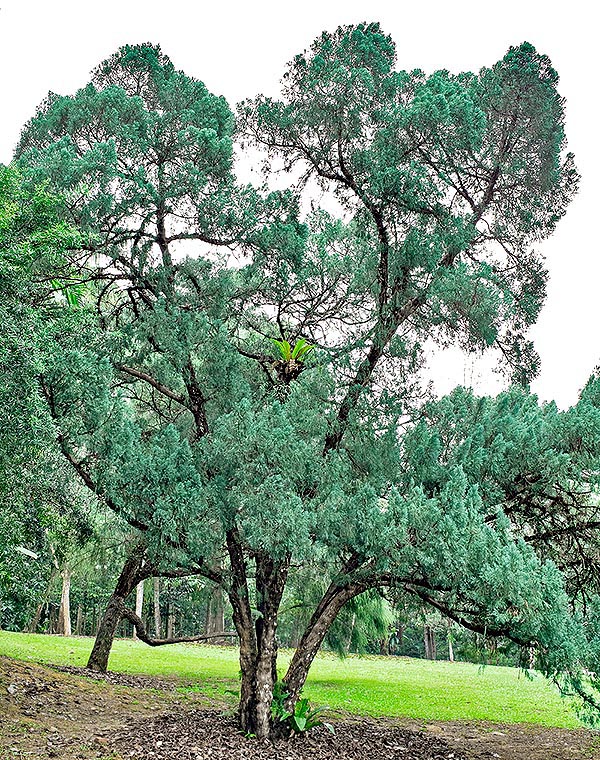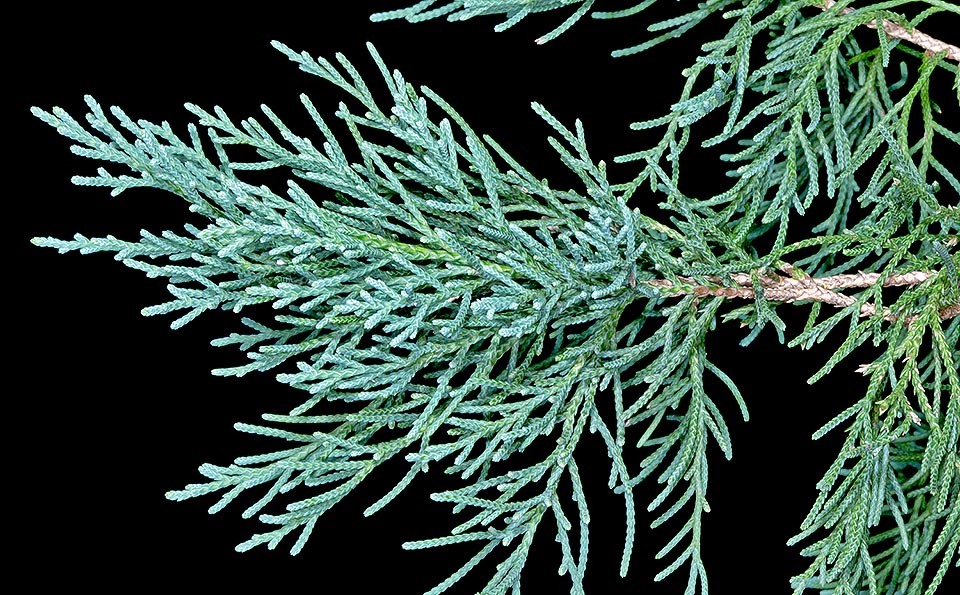Family : Cupressaceae

Text © Pietro Puccio

English translation by Mario Beltramini

In Taiwan forests, at 300-2000 m of altitude, Calocedrus formosana may exceed the 30 m of height © Giuseppe Mazza
The species is native to Taiwan where it grows in the evergreen forests of the central and northern part of the island, from about 300 to 2000 m of altitude.
The name of the genus is the combination of the Greek adjective “καλός” (kalós) = beautiful and of the substantive “κέδρος” (kédros) = cedar, name utilized for a not well defined conifer; the specific name is the Latin adjective “formosanus, a, um” = of Formosa, old Portuguese name of Taiwan.
Common names: Taiwan incense-cedar (English); tái wān xiào nán, tái wān cui bai (Chinese); cedro-do-incenso-de-taiwan (Portuguese).
The Calocedrus formosana (Florin) Florin (1956) is an evergreen monoecious tree, up to 30 m tall in the old specimens and diameter of the trunk at the base up to 1,5 m, with smooth bark tending to glake off in stripes with the age, of greyish brown to reddish brown colour, and alternate branchlets arranged on a plane.
Scaly leaves with pointed apex, decussate, imbricate, arranged in verticils of 4, of 2-5 mm of length and about 2 mm broad.
Solitary male cones at the apex of the terminal branchlets, oblong, about 4 mm long and 2 mm broad, of reddish colour tending to brown when ripe, formed by 8-14 microsporophylls (modified leaves bearing the pollen sacs) with pointed apex carrying 2-4 pollen sacs. Terminal female cones, solitary, oblong, 1-1,5 cm long and 0,5 cm of diameter, brown when ripe, with three pairs of scales, of which only the median is fertile, containing 1-2 ovoid seeds with pointed apex, laterally flattened, 4-6 mm long and 2 mm broad, provided with 2 unequal wings, the biggest about 1 cm long, the smaller reduced to a short lamina.
It reproduces by seed in organic sandy loam maintained humid at the temperature of 22-24 °C.
Species almost unknown out of its origin area, nowadays (2016) mainly present in Botanic Gardens, that would deserve a better diffusion due to its ornamental caracteristics and the adaptability to an ample variety of climates, from the tropical to the temperate, where it can stand temperatures up to -6 °C, if exceptional and short lasting, and of soils, acidic to slightly alkaline, even if preferring the sandy, draining ones, maintained almost constantly humid.

Little known out of its origin area, this nice plant might have a horticultural future in the temperate climates, as that it bears the -6 °C, is now in the red list of the endangered species due to the excessive exploitation of the wood and the deforestation linked to the agriculture. Medicinal virtues and oils useful in the termites struggle © Giuseppe Mazza
The wood, fragrant, of good quality and easy to work and to refine, has been utilized at local level in buildings, for furniture, handicrafts and artistic objects. Laboratory studies have shown the presence in various parts of the plant of compounds with antioxidant and anti-inflammatory activity; the essential oils extracted from the leaves have been found effective against the termites, thus representing a biological alternative to the chemical products.
Due to the excessive exploitation and reduction of the forestal areas, caused by the agricultural expansion, its presence is now limited to few isolated areas, and for such reason it has been inserted in the red list of the IUCN (Inernational Union for Conservation of Nature) among the species with extremely high extinction risk in the next future (Endangered).
Synonyms: Libocedrus formosana Florin (1930); Libocedrus macrolepis var. formosana (Florin) Kudô (1931); Heyderia formosana (Florin) H.L.Li (1953); Calocedrus macrolepis var. formosana (Florin) W.C.Cheng & L.K.Fu (1978).
→ To appreciate the biodiversity within the CUPRESSACEAE family please click here.
